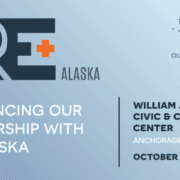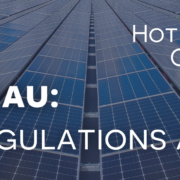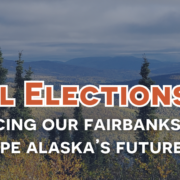Tag Archive for: alaska
Press Release: The Alaska Center Urges EPA to Uphold Endangerment Finding and Vehicle Emissions Standards
/in Blog, News, Press ReleasesClean Energy Can’t Wait: Alaskans are Ready for Real Action
/in Blog, Clean Energy, Climate, DemocracyAlaska’s Clean Energy Future: What’s at Stake Under Trump
/in NewsDuring the Biden Administration we saw a wave of unprecedented funding for our nation’s infrastructure. Both the Bipartisan Infrastructure Law (BIL) and Inflation Reduction Act (IRA), two pieces of legislation aimed at investing in American infrastructure, included substantial investments for green technology and clean energy projects. While many states have already begun to benefit from these federal dollars, we now risk a rollback that could reverse progress on our energy independence in Alaska.
Before entering office, President Trump and his transition team promised voters that his administration would make sweeping cuts to our national budget starting on Day One of his presidency.
On his first day in office, President Trump signed an executive order on American energy. The executive order directs all government agencies to pause the “disbursement of funds” appropriated through the BIL and IRA. It goes on to direct the Office of Management and Budget (OMB) to review plans for future spending against provisions laid out in the order. These actions put unspent funds at risk of reallocation or new restrictions.
A good portion of BIL and IRA funding has already been obligated, and therefore is more likely to be distributed as planned. This has done little to ease fears for funding recipients still in the early stages of project implementation, however, who worry that unspent dollars could end up being the subject of future litigation – leading to project delays and added expenses.
Monday’s executive order is likely just the beginning of directives aimed at federal infrastructure funding. The President has made it clear that Congress should not have the final word on federal spending. A president withholding appropriated funds (known as impoundment) is illegal, but Trump has promised to challenge the limits of this process in order to exercise complete control over the national budget.
President Trump has not been hesitant to test the limits of impoundment in the past. During his previous term in office, the Government Accountability Office determined that President Trump illegally withheld 91 million dollars appropriated for the development of cutting edge energy technologies under the Department of Energy (DOE).
Programs funded through the BIL and IRA have been very popular in blue and red states alike, particularly as Americans contend with rising energy costs and utilities struggle to meet increasing consumer demand. It’s unclear how precisely this upcoming budget battle will play out. What is clear is that President Trump is putting millions of dollars of investments in Alaska at risk.
In Alaska, planning is already underway for the rollout of Solar for All funding directed to benefit both household and community solar installations across the state funded by IRA legislation. The DOE and Environmental Protection Agency have also awarded funds to Alaska that would increase communities’ energy resilience during extreme weather, and boost the energy sovereignty of Alaska Native communities. Together, these programs would grow economic opportunities within the state and decrease greenhouse gas emissions.
As Alaskans are well aware, our building season is short, and even minor delays can have huge repercussions for project success. While the fate of new infrastructure projects born from the IRA and BIL remain uncertain, The Alaska Center is committed to ensuring federal funds for green energy stay in Alaska over the next four years. Join us in advocating to protect these funds while we also seek new clean energy investments from our state and local leaders.
With determination for Alaska’s future,
The Alaska Center
Bipartisan Majorities: A Win for Alaska’s Future
/in Blog, Democracy, Legislative SessionHey all,
If your inboxes are anything like ours, you probably have many messages about dark days, grief, and moving forward. The federal election results portend a big step backward for climate, democracy, and other issues our organization holds dear–but we will continue working diligently every day to fight for a thriving, just, and sustainable future.
However, this is not a message to process the federal fights to come. This email is a very brief note of hope and an achievement Alaskans can be proud of.
Our electoral goal this year was to maintain a bipartisan coalition in the Senate that’s aligned with our values and gain one back in the House. There’s a goal accomplished: Bipartisan Majorities were announced Wednesday, in both chambers!
This is a huge victory for Alaska. We’ve had a one-chamber bipartisan majority in one chamber since 2016, but this will be the first time since then that we have bipartisan majorities in both chambers. We hope this will mean fewer fights and more progress (shared values, good bills, political strength to do veto overrides when necessary, and more! Think of the possibilities of a functioning government!).
It’s been a hard week. But there are many, many reasons to hope. We wanted to make sure to share this one with you this Friday.
Best,
The Alaska Center
Be Informed + Learn About the Judges on Your Ballot
/in Blog, Democracy, NewsHey all! Something a little different this week—our friends at Alaskans for Fair Courts are guest-authoring our blog to share important information about judicial retention elections. With election season in full swing, we wanted to give you the chance to hear from the experts on this crucial part of the ballot. Check it out below!
Greetings from Alaskans for Fair Courts! We feel honored to have this opportunity to chat with you because we know how dedicated and involved each of you are in various community-oriented efforts in our great state!
I want to talk about judicial retention. Why? If you want to protect your values and your Constitutional rights, it is in your best interests to fill out the entire ballot as an informed voter. Here’s why.
Nineteen judges “standing for retention” are on the ballots this year – fifteen of whom will be on the ballot in the Third Judicial District, home to 2/3 of the state’s population, which includes Anchorage.
Why does this matter to you? Alaska’s state judges are the bulwark against attacks on the Alaska Constitution and/or the rule of law. They handle 95% of all cases, affecting a myriad of issues that affect all Alaskans, sometimes involving core constitutional rights that you value.
What is judicial retention? Unlike many other states, Alaska’s judges do not run campaigns to become a judge. Alaska’s Constitutional framers kept money and partisan politics out of judicial selection and retention. Wise folks!
Toward this end Alaska’s Constitution creates an independent, nonpartisan commission – the Alaska Judicial Council – to evaluate judicial applicants and seek the “best available timber.” The Council is comprised of: three non-attorney members appointed by the governor and confirmed by the legislature; three attorneys appointed by the Alaska Bar Association after polling its members; and the Chief Justice, who serves as an ex officio member who chairs the Council but votes only in those rare instances where there is a tie vote. The framers also concluded that judges should serve limited terms rather than lifetime appointments, requiring judges to “stand for retention” every so many years. Retention offers you an important role – to make the final decision about whether a judge should remain on the court.
This superior retention system – which is widely admired across the country – has produced judges who are dedicated to protecting the law while serving the community with integrity, professionalism, knowledge of the law, and respect for those who are in their courtrooms. We are lucky to have some of the best judges in the country.
Here’s why you can be so confident in our state judges. When a judge comes up for retention, the Judicial Council conducts a rigorous investigation of that judge, gathering information from thousands of people who have interacted with the judge, including jurors, court clerks, law enforcement, attorneys and social workers. The public has an opportunity to testify at public hearings. The Council compiles this information, grades the judges against judicial performance standards that reflect “best practice,” and votes whether to recommend the judge be retained. The Council’s findings, research, scores and recommendations are all on the Alaska Judicial Council website.
Unfortunately, since 2000, the “yes” votes in the 3rd Judicial District have declined by 7% – a downward trajectory that has now dipped below 60% for the first time in the State’s history. If a judge does not receive 50% of the votes during retention that judge loses their position on the court.
A number of factors have contributed to this trend:
- Voters not understanding how judges are selected and why they appear on the ballot
- Voters not finishing the ballot because they don’t know where to find information about the judges
- Eroding confidence in the judiciary exacerbated by national hyper-partisanship trends
- Individuals/organizations wanting to remove a judge because of an unpopular opinion or because a judge did not rule in their favor
- Efforts by individuals and groups within Alaska, and others from Outside, trying to destabilize our courts and replace our judges with ideologues
- Funding coming in from Outside extremist groups seeking to politicize Alaska’s state courts
If you don’t know the judges on your ballot, or don’t have the time to learn more about them, the Alaska Judicial Council has evaluated each judge rigorously and done the work for you! Check out their recommendations here!
For 64 years Alaskans have benefited from judges who were selected and retained by this process. Alaskans would not be well-served by a system that removes even one judge because of an unpopular decision, ideological differences, or because someone lost a case.
Please – When You Vote, Finish Your Entire Ballot!
Donna Goldsmith, Co-Chair Alaskans for Fair Courts
Check out the Find My Judges page at: https://akfaircourts.com
Beyond Juneau: Renewable Regulations and You!
/in Blog, Clean EnergyIf you joined us in celebrating some major policy wins with us this summer, you may have started to wonder what comes next. While we set our sights on our next policy goals for 2025, we also have important opportunities to continue to move toward a clean energy future for Alaska by engaging in the world of regulations.
On August 13, Community Solar was signed into law by Governor Dunleavy. Now, the Regulatory Commission of Alaska (RCA) has one year from the effective date to determine exactly how this program will function. The RCA regulates public utilities and pipeline carriers throughout the state, making decisions about rates, compliance with regulations, quality of service, safety, and more. In addition to support staff and analysts, the RCA is structured to be led by five full-time Commissioners, but currently only has four serving Commissioners.
With our partners, we have written about some of the specific decisions the RCA will need to make, including whether to extend its full net metering policy to community energy facilities so that subscribers are equitably compensated for the energy produced. As the RCA considers exactly how Community Solar will be structured, we encourage members of the public to make their voices heard. At the beginning of each biweekly public meeting of the RCA, members of the public are invited to speak for up to five minutes. During this period, you can introduce yourself and make a comment about Community Solar, clean energy, or anything else relevant to their work (as long as it is not related to an open docket).
Meanwhile, the Railbelt Reliability Council (RRC) is also making key decisions in the world of renewable regulations. This body, created by the legislature to create a more reliable and efficient railbelt energy system, is directed by a fourteen member board of stakeholders with an interest in railbelt reliability, representing the state’s Alaska Energy Authority, consumer advocates, environmental advocates, independent power producers, the electric utilities, and unaffiliated representatives.
The RRC has been moving forward toward the creation of an Integrated Resource Plan (IRP) for the railbelt, which will lay out the energy priorities for the railbelt for a twenty year period. This process includes identifying how much renewable energy should be brought online, what transmission and grid upgrades are necessary for proper integration and exchange of renewable energy, and how to ensure the overall system functions well (or how to ensure reliability across the system). Each of the railbelt utilities has created or will create their own version of an IRP, but an overarching plan will be an opportunity to build out the railbelt’s renewable energy generation most efficiently.
This multi-year planning process is underway with the Board currently working on establishing certain reliability standards that must be created before an Integrated Resource Plan is completed. The RRC currently aims to begin the IRP process in earnest by the first half of 2025, and complete that in a year. Additionally, the RRC’s Public Involvement Committee has been working hard to create clear opportunities for public outreach and engagement throughout this process.
Members of the public are always welcome to attend RRC Board meetings or Public Involvement Committee meetings, and to give feedback to the Board during the public comment section of their meetings. Information about upcoming meetings, including agendas, can be found on the RRC website.
Interested in learning more about the regulatory process or attending one of these meetings with support? Email Alex at alex@akcenter.org or stay tuned for future opportunities.
With energy for the future,
The Alaska Center
Local Elections Matter: Announcing Our Fairbanks Endorsements! Help Shape Alaska’s Future
/in BlogHi Friend,
If you turn on national news, it’s probably hard to avoid hearing about the Presidential election. Just the other day, I heard that this week marks “the start of the sprint to the Presidential election.” That might be true—but in Alaska, it’s also the sprint to the fall elections: state elections in November AND local elections!
Many municipalities across the state (including, but not at all limited to: Juneau, Palmer, and Fairbanks) have local elections in October, before the November elections. If you’ve followed The Alaska Center for any time, you know that we talk about local elections a lot. That’s because local elections are crucial: they govern our school districts, budget for everyday needs like snow-plowing, invest (or not) in local infrastructure like libraries, pools, trails, rec centers, and more. They’re also crucial to creating and implementing local climate action plans—like the one Fairbanks recently passed.
This year, our Political Committee made endorsements in the Fairbanks North Star Borough and Fairbanks City Council elections. Fairbanks is crucial to the political progress we can make in this state. Their October elections will be crucial to implementing the new climate plan, and deciding whether it collects dust or starts being used to make positive changes.
Thank you!
Best,
Jenny-Marie Stryker
Political Director
The Alaska Center









